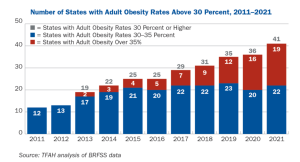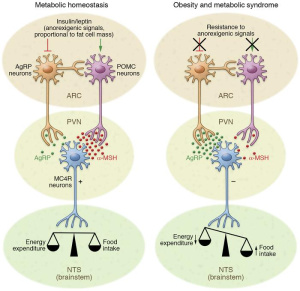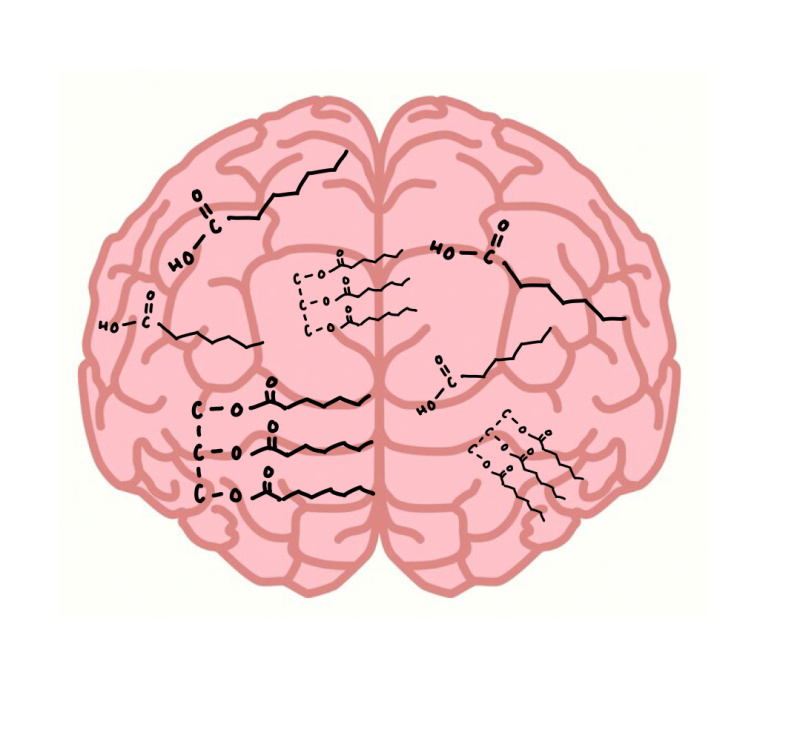Artstract created by Kailee Vigen
The Obesity Crisis
41.9 percent of American adults have obesity as of 2022. This obesity rate is due to many contributing factors such as race, genetics, environmental, and biological. Since 2021, nineteen states have announced a population obesity rate of 35% or higher. A decade ago, none of the fifty states were even near 35% obese. What has caused this increase, and what can be done to help the obesity crisis? With numbers as such, it is safe to say that this is not an individual problem – this is the nations, and even the world’s problem.

The only explanation for such an increase in obesity is, simply, increased caloric intake and decreased exercise causing weight gain. As treatment, it is advised to eat healthier and exercise more, which is attainable for some individuals, but not all. At such a large scale of obesity, our only hope for a “cure” is market changes and policy. One policy that has been proposed and is now implemented in Philadelphia, PA, Boulder, CO, and Berkeley, CA is a sweetened beverage tax. In Berkeley, this tax caused a 21% drop in sugary drink consumption. This is one promising example that such policies can help with the obesity crisis. It is discouraging seeing the healthy food priced at least two times more as the processed and fatty snack aisle in grocery stores. If healthier food costs were lowered and unhealthy foods were taxed, the obesity epidemic would see the end of its climb and plummet.
The Science
Biologically, obesity is more than just a bigger waist and greater amounts of adipose tissue built up throughout the body, it actually affects brain function as well. Altered brain function also contributes to obesity in individuals, but it all begins with diet – a high fat diet.
What is a High Fat Diet (HFD)?
HFD is the consumption of 35% of total caloric intake coming from fats, both saturated and unsaturated. These high-fat foods include the beloved and cheap processed foods we all know and love, animal fats, chocolate, butter, and oils. To put this diet into perspective, if one consumes 2,000 calories in a day, and 700 calories of that came from fats, equivalent to half a normal sized bag of Doritos, then this would be considered a HFD. Unfortunately, just this one day of poor eating can cause detrimental change to the brain and thus the body as a whole.
A HFD has been found to activate pathways causing leptin and insulin resistance – preventing individuals from feeling satiated and increasing blood sugar levels. This nutrient excess through overconsumption drives inflammation of the hypothalamus. This hypothalamic inflammation occurs even before weight gain. This inflammation alters the brain’s homeostatic and metabolic functions, contributing to obesity through such imbalanced energy and insulin resistance, as shown in the figure below. It has also been shown that HFD reduces synaptic plasticity, the body’s way of making new pathways for things learned and the formation of new memories.

Conclusion
The obesity epidemic is one of the largest problems in the US and in the world. Obesity is not only gaining weight, it also alters brain function and creates different neuronal pathways from a HFD. Obesity effects an individual much more than one would think, and that is alarming. Taxes on unhealthy foods are a strong start to deterring individuals from buying such cheap, fat-filled foods. Obesity is much more than an individual problem – the weight is truly in the country’s and world’s hands.
References
Farberman, R. (2022). State of Obesity 2022: Better Policies for a Healthier America. Trust for America’s Help. Retrieved April 12, 2023, from https://www.tfah.org/report-details/state-of-obesity-2022/#:~:text=Nationally%2C%2041.9%20percent%20of%20adults,obesity%20rate%20of%2045.6%20percent.
Blumenthal, D.; Seervai, S. (2018). Rising Obesity in the United States Is a Public Health Crisis. The Commonwealth Fund. Retrieved April 13, 2023, from https://www.commonwealthfund.org/blog/2018/rising-obesity-united-states-public-health-crisis
Kristantis, B.; Turner, D. (2020). High-Fat Diet. Advances in Cancer Research. Retrieved April 11, 2023, from https://www.sciencedirect.com/topics/agricultural-and-biological-sciences/high-fat-diet#:~:text=A%20high%2Dfat%20diet%20(HFD,%2C%20butter%2C%20and%20oily%20fish.
Jais, A., & Brüning, J. C. (2017). Hypothalamic inflammation in obesity and metabolic disease. The Journal of Clinical Investigation, 127(1), 24–32. https://doi.org/10.1172/JCI88878
